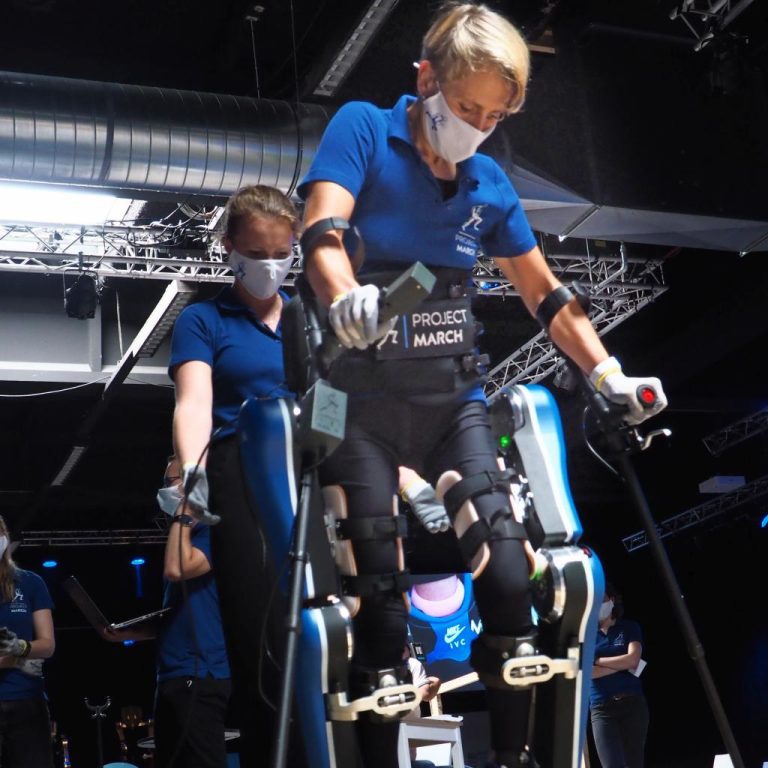Walking with an exoskeleton is an experience itself. Project MARCH has taken the next step by completing an obstacle course in preparation for the Cybathlon later this year.
Sjaan Quirijns climbed the stairs in the robot suit MARCH IVc during the demonstration. (Photo: Jos Wassink)
Suddenly, it became very quiet in the hall of the Bread Factory in Rijswijk. First were the introductory talks and some videos. And then Sjaan Quirijns walked in from the wings in the robot suit with her crutches. Students wearing face masks walked right next to her and behind her to catch her in case she fell. Quirijns walked jerkily with big steps to the obstacle course in the middle of the room. The audience on both sides held their breath in fascination.
It is the third year that Quirijns is in training as a paraplegic competitor with the TU Delft Project MARCH student team. For the first time, they are entering the Cybathlon international competition in Zurich, held every four years, this year where they have to tackle six obstacles. This is Quirijns’ third attempt at dealing with obstacles after two training sessions, but now in front of an audience. Looking tense, with trembling arms and a sweaty forehead, she faces the obstacle course. People seldom realise how complicated walking on two legs really is, and what a miracle it is that walking is effortless for most people.
The obstacles resemble obstacles that people with walking problems encounter in practice, says Eline Gigengack, Chief Engineer of Project MARCH. The first obstacle was the sofa from which the person has to get up. This requires a very strong robot suit and a firmly anchored pilot, in this case Sjaan Quirijns, in the suit. Then came the slalom where Quirijns slowed her walking pace to take the sharp turns. Then there was an uneven terrain with criss-cross attached semicircular beams over which Quirijns had to step in her exoskeleton and, using her crutches for support, take large and small steps.


“Down the stairs was the worst,”she said later. “You’re standing on that plateau and you’re looking down into the depths” says Sjaan Quirijns on the obstacle course. (Photo: JW)
The stairs were the highlight of the trial. Literally and figuratively. Getting to the top is demanding on the suit, and on the pilot whose arms were trembling from the effort. Once upstairs she triumphantly stuck her arm in the air. She had made it, but the hardest test was yet to come. “Down the stairs was the worst,” she said later. “You’re standing on that plateau and you’re looking down into the depths. I really had to focus to take each step right.”
Once down, a tilted path was the next challenge. Her left leg was higher than the right one, and her feet weren’t straight under her legs. This challenges the joints to keep the exoskeleton vertical, Gigengack said later. It helped that Quirijns, while walking, could herself change her step size. Finally, there was a slope that Quirijns had to walk up and down. This puts great force on the soles of the shoes, which are carbon-reinforced for maximum rigidity.
When Quirijns left the slope with her final step, the audience’s relief was palpable. Luckily she did not fall! And what an achievement by the student team and the athletic Quirijns. The applause lasted quite a while.
The preparation had not been easy, said Team Manager Jip Buis. Corona had put training to a standstill for three and a half months. Students worked together on Zoom and once a week there were software tests with the robot suit in one of the students’ parents’ barn. It was not until mid-June that training with Sjaan Quirijns could be resumed, complying with distance and face masks precautions.
The team was to focus on improving the MARCH IV suit and training for the international Cybathlon competition in September. In this event, the second ever held, people with physical disabilities compete against each other to complete everyday tasks using state-of-the-art robotic assistance. Due to the Corona crisis, the central event in Zürich has been split into national competitions in which teams from one country compete on the same track. These national competitions will be fused online into the virtual international Cybathlon on 13 and 14 November.


“It works and is more stable”, Quirijns notices about the robot suit. (Photo: JW)
Quirijns is more than satisfied with the MARCH IVc, as the current version of the suit is called. She finds that “it works and is more stable.” For her, the most important improvement is the better fixtures that attach her legs to the suit. She is also pleased that she can manually operate the suit through a control unit on her crutches. This enables her to adjust the step size and speed on the fly, giving her more control over the suit. The last improvement is that her upper body is more firmly locked in the corset.
In the coming months, Quirijns and the team will train on the obstacle course once or twice a week with the goal of becoming faster. The competition requirement is that the six obstacles are completed within 10 minutes.
While the old team will continue training with Quirijns until November, a new student team will start developing a new and even better robotic walking suit. And so, the MARCH goes on.
Do you have a question or comment about this article?
j.w.wassink@tudelft.nl


Comments are closed.